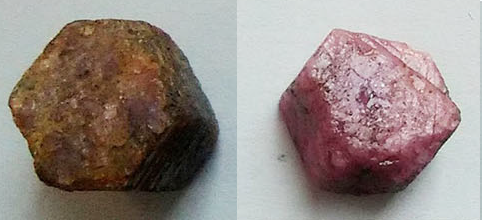Ruby red improves in the microwave oven

Institute of Minerals and Materials Technology (IMMT) have tested a new way to improve the colour, clarity and lustre of rubies: microwaves. The study, conducted by Subhashree Swain, is published in Springer's journal Applied Physics A.
Rubies are among the world's most popular precious gemstones, and are also used in high power switches and sensors. Most natural rubies are not uniform in colour, and sometimes blue patches can be seen in the red stone. This decreases the value of a stone.
Heat treatments count among the first methods to have been used to improve the colour saturation, clarity and trading value of gemstones. Treatments such as high energy, lasers, applying different chemicals or surface coatings and particle or electron beam irradiation are some of the other methods that have been used on rubies so far. The research team at IMMT is the first to add microwave heating to the possible methods of treating red gemstones. This technique has already been successfully used for materials such as ceramics, metals and composites.
They tested the technique on natural rubies collected from Sinapali in Odisha. These hexagonal prisms varied in size between 5 mm and 11 mm. The gemstones were placed in a basic 3 MW microwave furnace, and treated at 1500 degrees Celsius. The team then used various techniques to investigate and compare the microwaved ruby samples with untreated ones. These include X-ray diffraction, ultraviolet-visible spectroscopy, fluorescence spectrophotometry, Raman spectroscopy, and X-ray photoelectron spectroscopy.
It was found that the microwave treatment led to visible changes in the gemstones' colour and structure. In particular, the rubies changed colour from reddish black to light pink. The researchers believe this subtle change in the stones' surface colour and the increase in clarity may be caused by changes in the included chromium, iron and titanium elements. Fewer defects, irregularities and impurities in the stones were also noted, among others because of changes in their atom layout and crystal structure.
"Microwave heating, an unconventional method of fast thermal excitation, produces new results in gemstone like ruby," says Swain. "The study provides a new vista for future workers in the area."
She adds that the use of microwave heating has many advantages for the gemstone industry. It is a quicker technique than conventional heating, and ensures uniform heating, which in turn can aid rapid product development. It is also an energy-saving and eco-friendly process.
More information: S. Swain et al. Microwave heat treatment of natural ruby and its characterization, Applied Physics A (2016). DOI: 10.1007/s00339-016-9703-9
Provided by Springer



















